Introduction
ManageEngine Endpoint Central ensures that it provides 360-degree endpoint management and security software for your IT networks. It monitors all your network devices and security software and can be managed remotely to troubleshoot your endpoint with cloud-based solutions.
What is ManageEngine Endpoint Central?
ManageEngine Endpoint Central is endpoint management software that can manage client’s desktops, servers, laptops, and mobile devices from a single central location. With its help, you can remotely troubleshoot, manage, and monitor your client’s devices.
Self Service Portal Endpoint Central handles the desktop management, like installing the patches, distributing the new software, and setting up the client system automatically. It also supports managing the IT assets and licenses of the software and provides a report on which software is currently properly working and the software’s status. It provides reports of devices that are under the security console.
Mobile devices and tablets can be configured and managed by the Mobile Devices Management (MDM) feature of ManageEngine Endpoint Central.
What is EndPoint Central?
What is Endpoint Central?
Endpoint central is a software tool that allows users to manage all endpoint software in a single location. It is a client-server model that can do many task automatically, like:
- Installing patches
- Distributed New Software’s
- Setting desktop
- Power Management setting
- Users setting
- Computers setting
Endpoint Central is software that is a part of ManageEngine and a division of Zoho Corp. ManageEngine provides 60 and above enterprises IT management products and tools.
ManageEngine Endpoint Central Features
There are several features, which are given below in detail:
1. Patches and software update management
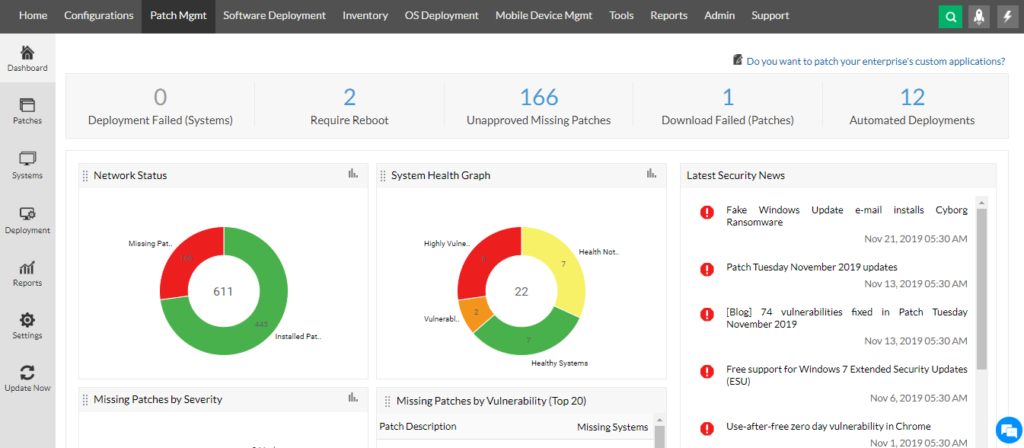
With the help of this application, you can update the software with remotely and install the patch software of the client-side devices. It can be scanned, detected, tested, and deployed automatically, which is forgotten by users.
You can install third-party software, desktop applications, and automatic updates.
2. Malware Protection
You can detect and prevent malware on devices. Immediately quarantine infected devices and neutralize attacks of viruses in real time. Lock the ransomware attacks with top encryption shields and recover with a single click. Endpoint Central provides immediate alerts on suspicious activity. It is advised to isolate the infected devices which are in risk of movement. You can automatically roll back and restore affected systems to clean states without losing data with the help of Endpoint central management.
3. Browser Security

ManageEngine Endpoint centrally locks down the browser and specific websites that are based on browser attacks. It gives blocking features like address bar, toolbar, and menus and prevents the user from changing the browser setting. Isolation of the browser is a very effective way to protect browser-based attacks like malware, phishing, and downloads.
4. Applications Management

Endpoint Central controls the applications, manages the execution of the software, and provides limited access based on specific needs. It is providing two approaches, like block listing and allow listing of the applications. From the admin side, he can create an application list that allows only one application to run and blocks another application from running on the network. It has some sub-features of application management:
Enhanced Security
It is reducing attacks and allowing trusted applications to execute the risk of cyber attack
Access Customizations
Application allow access based on user roles, and it provide a more secure and efficient digital environment. Unauthorized application blocking features restrict unauthorized malicious applications running from network devices.
Reduces the attack
Minimizing the risk of cybersecurity attack and preventing unauthorized access to data.
5. Data Security

Endpoint central discovers the sensitive data, finding and classifying sensitive information within the organization endpoints. It is controlling access to sensitive data that can harm a company and be relevant to others. It is monitoring this type of data to identify the information in it and ensure that it is protected. There are several tools to protect the data; one of the famous tools is described here
Data leak prevention from Data loss protection (DLP)
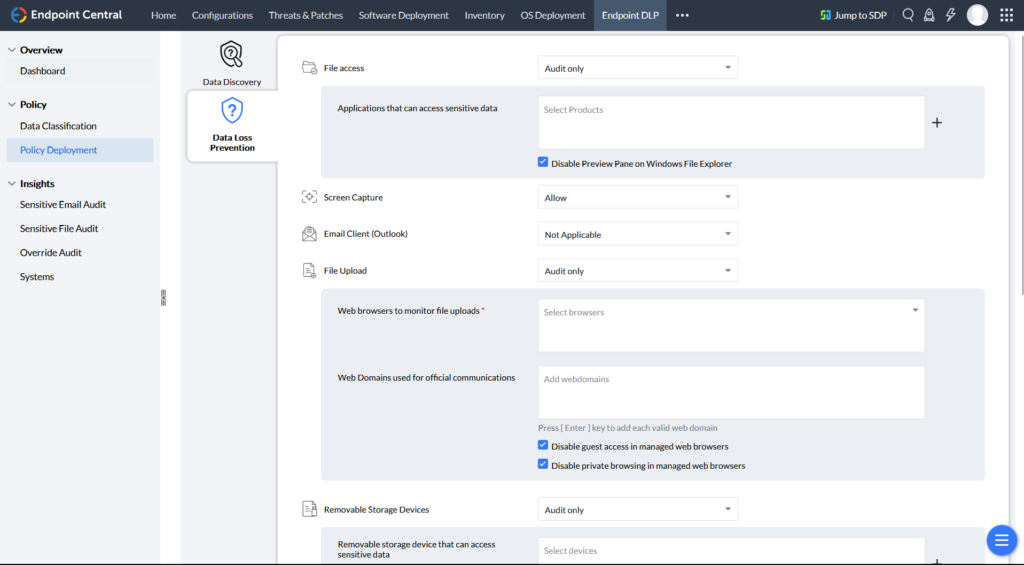
Data loss prevention (DLP) is a special feature of ManageEngine Endpoint Central that creates a strategy for protecting sensitive data from theft, loss, and unauthorized access. DLP tools feature includes for data classifications, data transfer, access control, policy and incident management, auditing and altering. DLP tools prevent data loss and theft. Data loss can occur in several ways, like- User’s mishandling, Physical loss, cyberattack. DLP tools monitor and control the data for transferring auditing and editing.
6. IT Assets Management (ITAM) Software
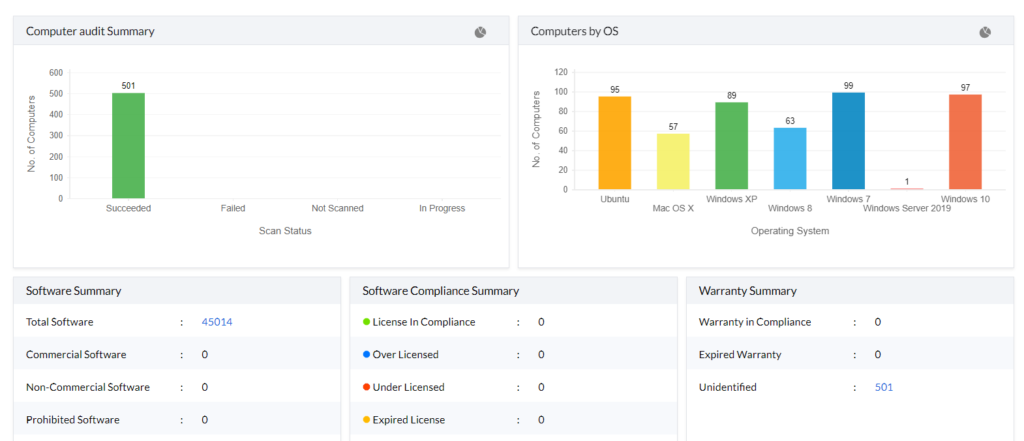
IT Assets Management software is program that monitors the IT assets which are connected in the organization’s network. It is tracking the organization’s assets for entire duration. You can manage the hardware and software in your network anywhere, anytime, from laptop or desktop with the help of IT assets management software.
ITAM software can help track digital assets with the help of assets scans, which are a feature of ITAM software. You can configure alerts and notifications of any changes of hardware and software inventory. There are several feature included in IT asset Management software
Tracking the IT assets
Manage the software license
Manage the hardware warranty
Setup the inventory alert on real time
USB devices management: Manage the uses of USB devices, like disabling and blocking them. You can restrict the the USB devices on computer and at the user level. You can enable/disable following devices for users and computers: Mouse, Disk Drive, CD-ROM, Flopy disk, Bluetooth, Image, Printer, Modem, Apple Devices, and portable USB devices.
You can keep record of these activity for future audit purpose.
7. Software Deployment automatically
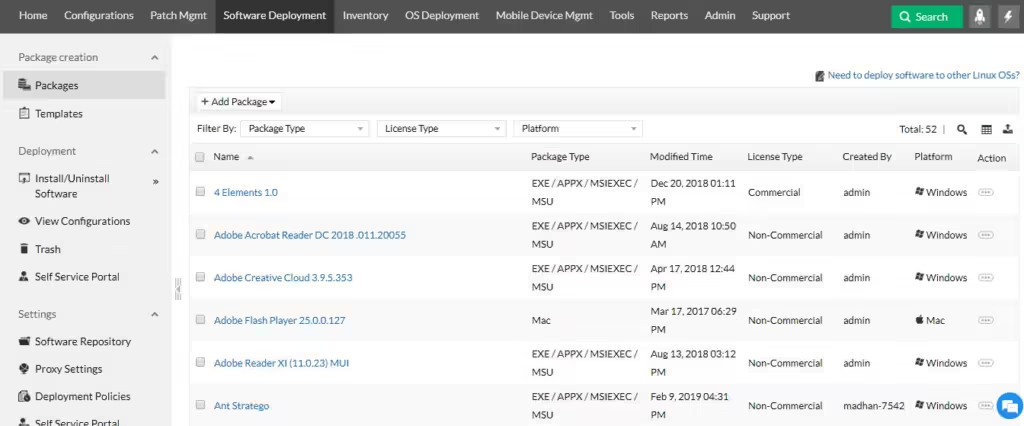
Software deployment automatically is the best feature of ManageEngine Endpoint Central. This feature provides automatic distribution of all packages with zero intervention. Distribution of the software to all machines within the network can be performed by IT administrators of large enterprises. Endpoint Central allows to deploy the software and packages automatically on network computers on any Windows, Mac, Linux, iOS, Android, or Chrome OS.
Automated software deployment features come with pre-defined application templates. In this area, you first create the software packages for deployment. It has automated software installation tools with pre-defined application templates.
All software packages which are created by software deployment are stored in a central Software Repository. Once packaged and saved, you can use multiple time in your organization for deployment purpose. In this area, there are two type of software repositories:
Network Share Repository: It is used when deploy the software from LAN agent.
HTTP Repository: It is used when deploy the software packages to WAN agents.
Another feature included in software deployment tools is:
Mobile app distribution
Software Monitoring
Self-Service Portal
Schedule Deployment
8. Remote access and troubleshooting
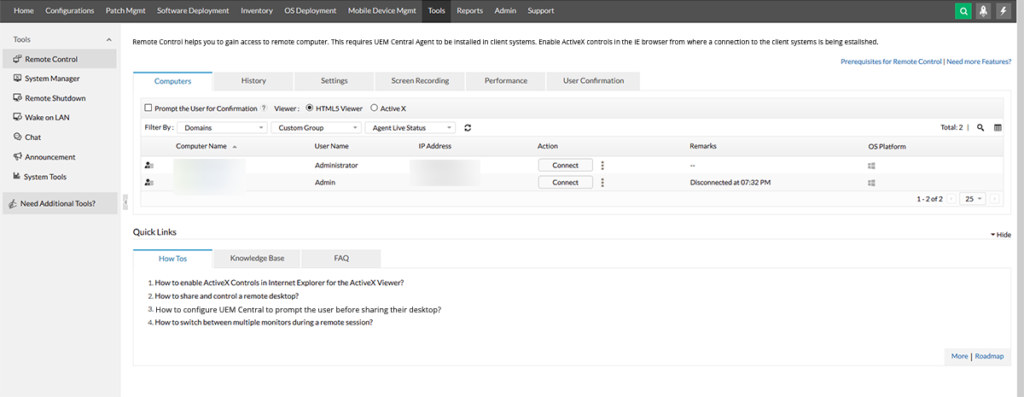
There is another feature of ManageEngine Endpoint Central: remote access and troubleshooting. As the name suggests, endpoint central enables remote desktop tools to connect and control remote desktop and mobile devices on network. This is a web-based tools to access computers anywhere in the global area.
What is remote desktop?
It is technology that allows a user to access and take control of a computer from another location over the internet or same network. The user can access files, applications, and other types of activity like installation/uninstallation the application with the help of remote desktop application.
Web-based remote control facility: It provide the web-based facility to take remote computers.
Recording Remote Session: Administrator can view the recoded of remote session activity and check data security.
9. OS Deployment
OS deployment is an important part of the IT department, but this task is very complicated and takes a lot of time. In Endpoint Central, there is a feature for OS deployment. You can assign the disk and deploy the OS process. The administrator captures the image of different OS version, customizes it, and deploys it to new system from the console. There are several feature included in this area:
Remote Office Management
Modern Imaging Techniques
Hardwar Independent Deployment
Post-deployment configuration
10. Configuration Management
Configuration management is the way to manage the system systematically and handle any changes to organization’s system. It is tracking the hardware, software, applications, documentation and different configuration parameters. Endpoint help manage the system on centralized hub and configure it across an organization’s endpoints.
ManageEngine Endpoint Central provides administrators with features to manage applications, system settings, desktop settings, and all security policies. This is very helpful to administrators that target the system and can be managed at user or system level.
It has different level of configuration, like:
User-based and computer-based configurations: Endpoint provides configuration on user-based and computer-based configurations. User-based configuration allows the administrator to set settings based on individual user accounts; on the other hand, computer-based configuration allows for device-level configuration.
System Configuration: It configures things like operating system settings, network configurations and security policies.
11. Server Infrastructure Management:
Most organizations across all sectors rely heavily on server infrastructure to host applications, store critical data, and facilitate communications. Effective server management is essential for optimal IT performance. This is best achieved through integrated endpoint management and security solutions such as ManageEngine Endpoint Central, which allows infrastructure and operations (I&O) teams to efficiently oversee administrative responsibilities while ensuring optimal server infrastructure security and reliability.
Manage the Server lifecycle
Because different servers often run different operating systems, I&O teams typically maintain separate caches for each OS to ensure compatibility and proper management. This increases the administrative burden on the organization and requires more resources and effort from the I&O team. Endpoint Central simplifies this process by providing a unified cache server that supports multiple operating systems, streamlining operations and centralizing the storage and distribution of OS updates, patches, and software packages.
IT automation
Automation is the key to improving IT efficiency and allowing organizations to focus resources where they are needed rather than on routine, repetitive tasks. Server administrators can choose from over 350 ready-to-use script templates within Endpoint Central to automate daily processes and workflows. For unique business-specific scenarios, server administrators can customize scripts to suit their needs. To automate redundant tasks related to server patching, Endpoint Central allows I&O teams to use settings and scripts to define deployment policies before and after patch deployment. For example, a system administrator can check if a backup server is ready before shutting down the primary server for patch deployment.
Conclusion
ManageEngine Endpoint Central (formerly Desktop Central) is management software which can manage desktop and mobile devices from a central location. It is offering remote management, maintenance, configuration, and management of all workstations, laptops, and desktop devices within the organization. It allow for desktop management, installation of patches, distribution of new software, and the setting of desktops, computers and users.
follow me : Twitter, Facebook, LinkedIn, Instagram

